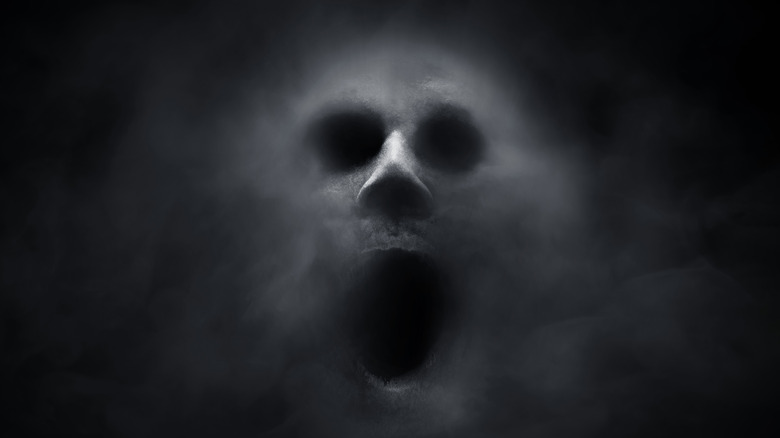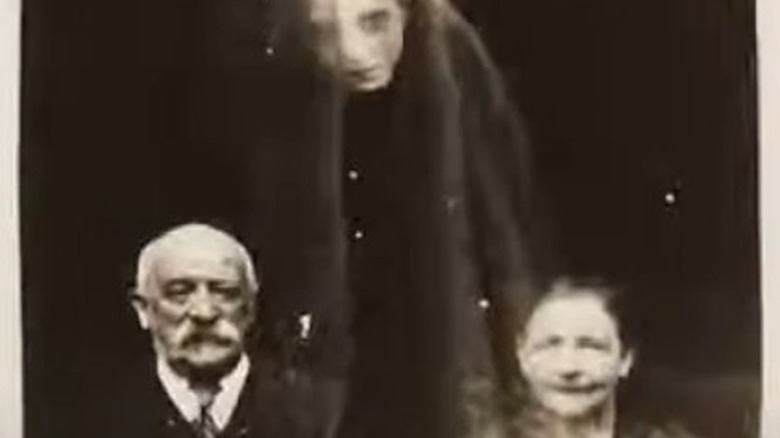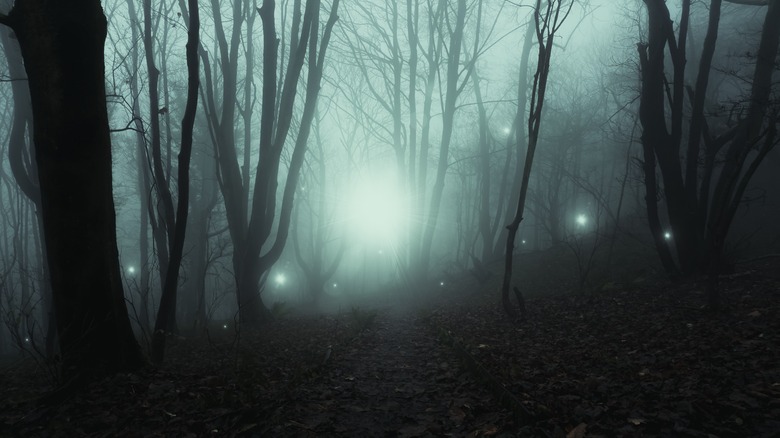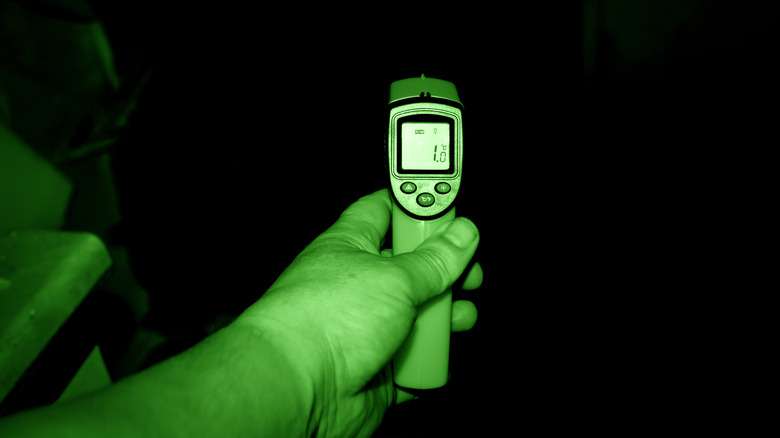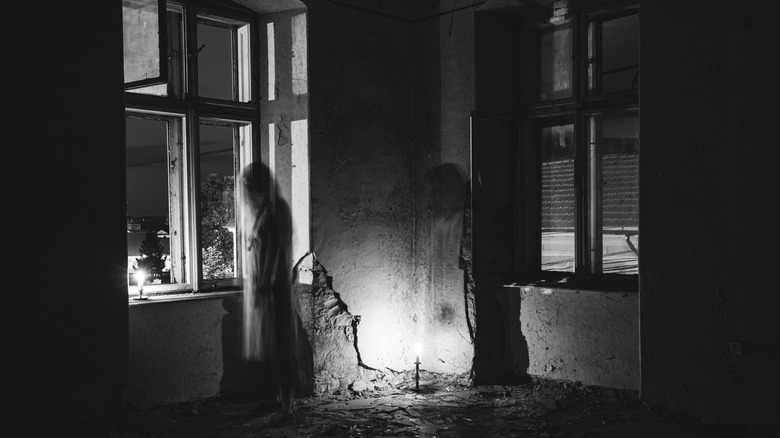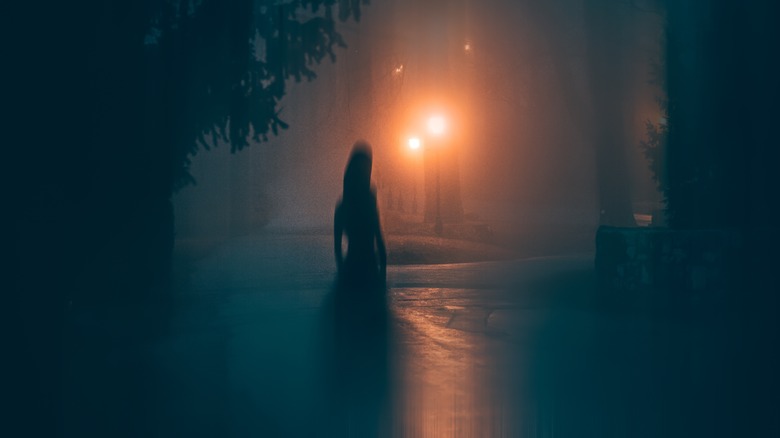The Weird Science Behind Ghost Hunting
Do you believe in things that go bump in the night? According to a 2019 IPSOS poll, 46% of Americans believe in ghosts. This is up from 32% in 2005 and almost double the 25% percent that said the same in 1990, according to The New York Times. With numbers so high, it's no surprise ghost hunting has become so popular in the media — something that, in turn, has also increased the interest in the paranormal among "regular folks."
Ghost hunting, however, is an inexact science. For starters, there's no concrete proof that ghosts exist, so when investigators claim to make contact with a spirit, we're still left wondering. According to an article in Live Science, this is in great part due to ghost hunters not applying critical thinking or using scientific methods during their investigations. If you claim you're skeptical but the first sounds you record make you yell "ghost," just how much science are you using to determine if a ghostly presence is truly there?
Another problem is that a lot of the fancy equipment used by ghost hunters today doesn't work the way they tell you it does, so proper scientific research can't be really conducted using it.
Famous Ghost Hunters
You're probably most aware of the existence of ghost hunters because of the many TV shows dedicated to it today, such as the hit SyFy Channel's show "Ghost Hunters," "Ghost Adventures," and "Paranormal Lockdown." But paranormal researchers have been around for a very long time, and the business of (and fascination with) searching for ghosts is nothing new. In the early 1900s, William Hope was famous for his "spirit photography," depicting ghostly figures that would appear on film while he was photographing people. That is until he was exposed as a fraudster by author and investigator Harry Price in 1922 (via The Public Domain Review).
Harry Price was an avid ghost hunter and a member of The Ghost Club (which also counted Charles Dickens as a member), the world's oldest organization dedicated to discussing and investigating ghosts and psychic phenomena.
Ed and Lorraine Warren are better-known paranormal investigators — at least if you've seen "The Conjuring" movies — that rose to fame in the 1950s for dealing with very prominent cases of possession and ghost hunting. The couple founded the New England Society for Psychic Research and eventually became involved in thousands of cases, including the Amityville haunting. The couple dedicated their entire lives to the paranormal world, and Lorraine only retired after Ed died of a stroke in 2006, according to All That's Interesting.
What ghost hunters look for
In an article published by the McGill Office for Science and Society, author and science communicator Jonathan Jarry points out that ghost hunters aren't really hunting for ghosts when they go out into the dark nights — they are hunting for anomalies. This means any instruments or techniques used during a paranormal investigation are not meant to prove that ghosts existed; it's simply meant to capture indications of "something" being there, whether that's an unexpected sound, image, or feeling.
Two easy-to-detect things ghost hunters look for are orbs and cold spots. These are an important part of ghost hunting because they don't require high-tech equipment to be detected. Orbs are spots that appear on photographs as glowing balls of light or circular white spots. And while ghost hunters might claim they could indicate spirit energy, they're usually easily explained as dust or other airborne particles (per Live About).
Cold spots or significant drops in temperature that happen quickly are also sometimes associated with the presence of ghosts. Still, there's also no scientific theory explaining why ghosts would cool down a room (as reported via AccuWeather). Still, many paranormal investigators use equipment like thermometers, air ion counters, and thermal cameras to detect changes in the temperature of a room, even though that proves nothing except that the air temperature has changed.
Equipment used for ghost hunting
If you watch ghost hunting reality TV shows, you've seen the cast carry a number of ghost hunting pieces of equipment every time they go somewhere to investigate. These items have become standard tools for paranormal investigators (though some of the tools are more unusual than others).
Most investigators carry, at a minimum, both photo and video cameras. Some have several, including not only digital cameras, but also infrared and thermal vision cameras to catch changes in temperature. Night-vision goggles or cameras are also great in darkness and catch things the human eye would miss. Basic video recorders are also sometimes used to catch voices or sounds (via SF Gate).
Structured light sensor (SLS) cameras are another great tool as they project infrared light and catch movement in the form of 3D shapes. According to Go San Angelo, these cameras catch solid things (like a human being), so if there's noise or a voice coming from one direction and the camera doesn't catch anything, this would tell you that the voice is coming from a spirit. Investigators often also carry motion sensors and electronic voice phenomenon (EVP) detectors to catch voices and sound through static, and electromagnetic field meters (EMF) meters which detect changes in the electromagnetic field when anything (like a ghost) gets close to it.
The science of electronic voice phenomena
Perhaps one of the most common pieces of equipment you'll find among ghost hunters is an EVP detector, used to capture potential voices or sounds produced by spirits. According to Skeptical Inquirer, the idea is that a ghost might not be able to produce a sound loud enough for you to hear in real time, but a recorder could still capture that voice.
Surprisingly, it was Thomas Edison who came up with the idea of the first EVP detector. As reported by Forbes, Edison announced in 1920 that he was working on an "apparatus to see if it is possible for personalities which have left this earth to communicate with us." Unfortunately, a prototype for Edison's "ghost machine" was never revealed or found after his death.
More than 30 years later, two priests would accidentally record the first-ever EVP using a magnetophonon (via The British Psychological Society). Per Ghostwatch, While recording Gregorian chants, the priests caught the voice of Father Gemelli's dead father saying, "I'll always be with you."
Modern digital recorders and computer programs that improve sound quality are a world away from Edison's EVP machine, but with technology growth and data manipulation also comes more doubt. For example, Skeptical Enquirer points out computers make it easy to edit and "improve" the quality of sound so much it might actually lead to us hearing something that isn't really there.
Skepticism and why we believe
With no general consensus of what a ghost really is or looks like, it's hard for investigators to remain professional about their search. Skeptical Inquirer recounts the example of a "groundbreaking experience" conducted in 2015. Using a so-called "ghost box" or SB7 spirit box, a group of investigators used a modified radio sweeper that goes through AM/FM frequencies to identify "answers from spirits" to questions being asked by the researchers.
In reality, the experiment only proves one thing: Ghost hunters will hear what they are inclined to or already have a tendency to hear. This is not different from a sound heard in an EVP. It could be nothing to some or sound like a word or a whisper to somebody actively listening for proof of the paranormal. According to Skeptical Enquirer, it's almost impossible to remove group bias from an investigation that uses methods that rely on interpretation.
There's also the human need to make sense of and find patterns in things. According to The British Psychological Society, when you're listening to an EVP, there will be a tendency to try to connect and understand what you're hearing, bringing your prior beliefs and expectations into play. And if you're part of the more than 40% of people who already believe in ghosts, spirit-based hauntings, or the paranormal, you might be inclined to think what you hear in that recording is really a ghost. Ultimately, it might just come down to that rather than science.
